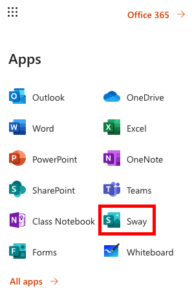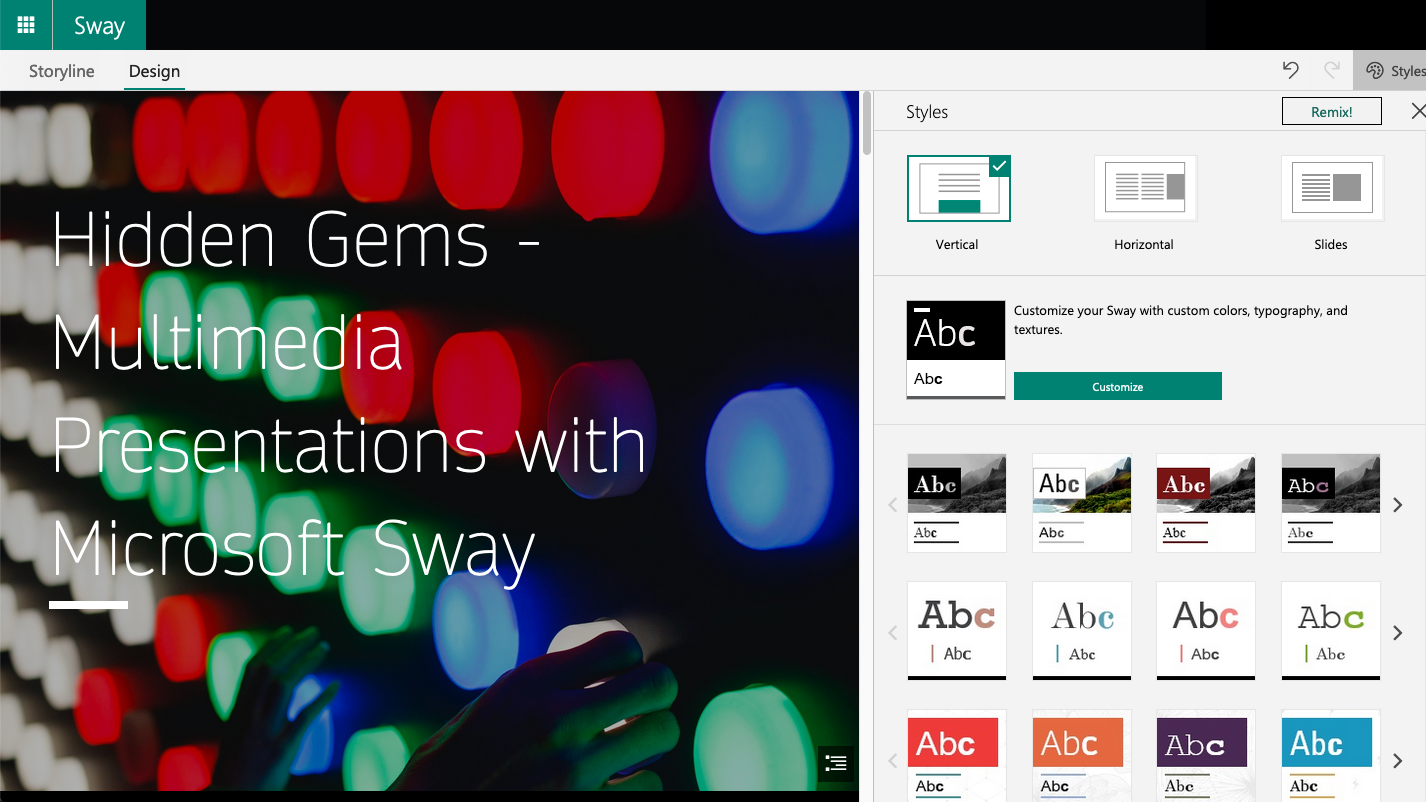Scenario
Jamie Jameson is teaching a combined 400/800 level course this term and the final project is a group presentation of their students’ work as a digital poster. In previous years Jamie’s assignment was often submitted as a PowerPoint presentation. This year they wanted to try something new, enabling students to create and curate multimedia into the presentation, as PowerPoint always made this feel clunky; as well as asking students to create something that is shareable not only in a remote learning context but is also easily shared with a broader audience.
Jamie considered continuing to use PowerPoint, but having students work in groups would sometimes result in multiple versions and led to confusion about which draft to present to the class. Sharing of the PowerPoints was also a problem. If PDFs were shared, the presentations felt static and lacked the multimedia elements that enhance the presentation. Visually rich presentations resulted in very large file sizes and could become increasingly difficulty to distribute, not to mention that viewing them on different devices could drastically alter the perception of the presentation. Jamie also considered asking their students to create a website, but concluded that their own comfort level with teaching their students the intricacies of web design could detract from the purpose of the assignment, the students’ research.
After consulting with an instructional designer about the project, Jamie settled on the final assignment submissions by way of Microsoft Sway. Their students created responsive Sway presentations of their research collaboratively online, presented it to the class, and they were also able to post their Sway projects to the class website.These presentations were brought to life with pull quotes, animations, student created video as well as YouTube videos, and images. Finally, students were able to include their work in the e-portfolio they assembled over the course of their program.
What is it?
Microsoft Sway is a web-based digital storytelling platform that enables instructors and students to create visually appealing, presentations, interactive reports, and newsletters. What makes it unique is that you can use it to combine text and media to create a presentable website quickly and easily. You can pull content locally from your computer, or from internet sources such as Bing, Flickr, OneDrive, and YouTube. This platform is designed to be easy to use and to create a storyline. Templates and functions are accessible and shareable, and the presentations are responsive, playing beautifully on any device.
How does it work?
From your web-browser, you can create a Sway from scratch, import a document or PowerPoint (which gets automatically sorted into your chosen template, some editing required after this), or start with a template. From there you create your presentation title, choose a background, create headings, and add the main content element in Sway, “Cards”. A card can be text, an image, an interactive element (such as a stack of images, or image carousel), a multimedia item such as a video, or even another MS Document.
[image_carousel source=”media: 959,960,961,962,963″ limit=”20″ slides_style=”minimal” controls_style=”dark” crop=”16:9″ columns=”1″ adaptive=”yes” spacing=”yes” align=”none” max_width=”none” captions=”no” arrows=”yes” dots=”yes” link=”none” target=”blank” autoplay=”3″ speed=”medium” image_size=”medium” outline=”yes”]Once you have your content in place, you can adjust the styles (colour and text themes) and check the result immediately using the Design feature. Finally, it will be time to share your Sway, which can be a shared link, an image card in an email, embedded on another website, or shared via Office 365. Others with Office 365 can collaborate with you on the same Sway, avoiding the dreaded versionitis you might have experiences sharing documents and slidedecks with mutliple collaborators. A Sway can also be password protected to limit who can view it.
Why would I use this?
The sweet spot for Sway is when you want to create a presentation, or content page, that is adaptive and media rich that plays like a website (as opposed to how PPT presents content), but does not require the creation of a full website using a publishing platform (like WordPress or Drupal). Sway also does not require any coding skills. As an online tool you and your students should find it user friendly and intuitive.
What are its limitations?
The major limitation of Sway is that to author and view presentations you must have an internet connection. So long as you have that, you can author and view materials using any web-browser.
Long time users of tools like PowerPoint, Keynote, Google Slides, or Publisher might also find some of the authoring options limiting. For example, when placing images into a Sway, you do not dictate pixel by pixel where the image is to be placed. You instead have some general settings, and can easily adjust the “focus” of the image for how it appears within the template scheme on various devices. Theme colours and font choices are still highly customizable, but many of those other page layout features you’re used to having control over slide-by-slide are much more limited. Partly this is a conceptual shift from “slides” to “headings” and a continuous web-page.
Implications for teaching and learning
Demonstrating learning can take many forms, from papers, to oral presentations, to projects and more. Sway provides a way for students to demonstrate their learning in a visual digital storytelling medium suitable for presentations, portfolios, summaries and annotated bibliographies, and creative works. Sway enables Collaboration (acts as a platform for collaboration and co-creation), Creation (building learning resources from scratch or remixing existing resources), and Curation (a platform to collect, organize, and share content).
How to Get Started
Sway is one of the Microsoft Office 365 Suite apps and can be accessed by USASK students and staff through their Office 365 Portal (requires an NSID; use your NSID@usask.ca as the email) or through the OneDrive link in PAWS.

In addition to starting from scratch, there are three ways to jump into creating your first Sway. Consider what works best for you by reading the three options below:
[accordion][spoiler title=”Start from a Document” open=”no” style=”fancy” icon=”plus” anchor=”” class=””]If you already have your presentation materials in a Word Document, a PowerPoint, or a PDF, you can import it straight into Sway. From there, Sway will read the headings, slide titles, or titles in the PDF, import the images, and provide a rough outline for your presentation based on the order of those items. Rather than starting from scratch, this approach gives you something to work with, you can make any edits you need from an established framework. Note: if you do not properly format you Word document (i.e. do not use headings) the conversion may not produce the results you’re hoping for.Read more [/spoiler] [spoiler title=”Start with a Topic” open=”no” style=”fancy” icon=”plus” anchor=”” class=””]By choosing this route, you enter a topic and Sway will create a suggested organizational framework, drawing on the Wikipedia entry for the topic. Sway will create titles, headings, text sections, and image sections. It does not create captions, but organizes images into the headings from the topic entry. From here, you will have clear sections and captions to create material for if you do not already have your material written. If you do already have your material written, then copy/paste your content into sections in a Sway. This option is for you if you prefer to start with content, but do not want to worry about choosing a style or structure yourself.[/spoiler] [spoiler title=”Start with a Template” open=”no” style=”fancy” icon=”plus” anchor=”” class=””]If this is your first time using Sway, it can be difficult to imaging the possibilities or what the final product could look like (especially from the blank editing screen you get when starting from scratch). Similar to other MS Office products, Sway has a series of templates that can help get you started that are categorized by purpose. You can browse the templates for a style and structure that suits your needs and aesthetic. The templates that work might be best to check out first include: Portfolio (Photo Collage), Student Report, Presentation, Blog (enhanced), Newsletter, and DIY Project. This option is for you if you prefer to start with a structure then produce content. [/spoiler][/accordion]
Additional Resources
If you would like to see some examples of presentations and projects made using Sway here are a few that caught my eye and one first try at converting a previous presentation to the new format:
- Ingredients for Interaction in Online Learning (vertical layout)
- Universe_Cheatsheet (horizontal layout)
You can get started with Sway by accessing it through your online Microsoft Office 365 portal or by downloading the apps and signing in. For a great walkthrough of the features and steps to create your first Sway in less than an hour, check out this course on LinkedIn Learning.


